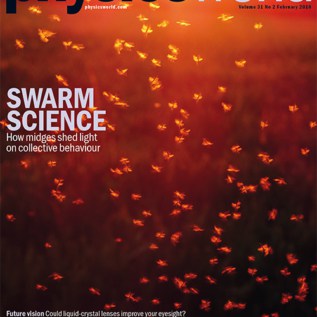
By Matin Durrani
You’ll be delighted to know that the February 2018 issue of Physics World is now out in print and digital format.
In our cover feature this month, science writer Jennifer Ouellette discovers how tiny midges can shed light on collective behaviour in physics. You can also discover from Helen Gleeson how physicists are seeking to create liquid-crystal contact lenses – and learn from Stephen Ornes more about the technological challenges of going to Mars.
Don’t miss either our interview with the physicist who heads Japan’s leading funding agency and find out from astrophysicist Elizabeth Tasker about her experiences as an overseas scientist in the country.
And our veteran North America correspondent Peter Gwynne assesses the impact that Donald Trump has had on US science, one year into his presidency.
Remember that if you’re a member of the Institute of Physics, you can read the whole of Physics World magazine every month via our digital apps for iOS, Android and Web browsers.
Let us know what you think about the issue on Twitter, Facebook or by e-mailing us at pwld@iop.org
For the record, here’s a run-down of what else is in the issue.

• Donald Trump: one year on – When Donald Trump took over as US president, many scientists feared for the worst. One year into his presidency, those concerns look set to
continue, as Peter Gwynne reports
• Japan’s funding supremo – Yasuhiro Iye, a condensed-matter physicist who is executive director of the Japan Society for the Promotion of Science, talks to Matin Durrani about the pressures and challenges facing Japan’s biggest funding agency
• Protecting innovation – Mark Saunders argues that in a post-Brexit Britain, the UK
economy should be safeguarded by providing sufficient protection of innovation
• The business of physics – In this new series of columns, James McKenzie aims to raise the profile of industrial physics and explore the value and relevance of physicists to industry
• Collecting books – An important document collection is about to transform the history of physics holdings at the Niels Bohr Library, says Robert P Crease
• The long road to Mars – With ambitious plans being dreamed up to send astronauts to the red planet, what challenges would face them if they ever went – and what technology would they need? Stephen Ornes finds out
• Looking – into the future – Having to wear reading glasses as you get older may soon be a thing of the past. Helen Gleeson describes her team’s research into liquid-crystal contact lenses that will be able to switch focus and restore youthful vision
• Sounding out swarms – Swarms of midges might be an annoyance if you’re out walking in the woods, but for physicists they offer unique insights into collective behaviour, as Jennifer Ouellette finds out
• Boldly going to a galaxy far, far away – Andrew Glester reviews Treknology: the Science of Star Trek from Tricorders to Warp Drives by Ethan Siegel and The Physics of Star Wars: the Science Behind a Galaxy Far, Far Away by Patrick Johnson
• Of graphs and giggles – Tushna Commissariat reviews Festival of the Spoken Nerd: Just for Graphs – a DVD from Laughing Stock Studio/Trunkman Productions
• Tales from a British physicist in Japan – From cultural differences to grant glitches, Elizabeth Tasker describes the good, the bad and the confusing of working as a physicist in Japan
• Once a physicist – meet Anna Starkey is the creative director of We The Curious
– an interactive science centre in Bristol, UK
• The positive side of negative marking – Colin White from the University of Portsmouth recalls an unusual experience as a physics examiner
And don’t forget, if you have any thoughts on the issue do let us know on Twitter, Facebook or by e-mailing us at pwld@iop.org.



